Artists' Writing
Artists' Writing

Polyamorous Love Song
From interdisciplinary writer and performer Jacob Wren comes Polyamorous Love Song, a novel of intertwined narratives concerning the relationship between artists and the world. Shot through with unexpected moments of sex and violence, readers will become acquainted with a world that is at once the same and opposite from the one in which they live. With a diverse palette of vivid characters - from people who wear furry mascot costumes at all times, to a group of New Filmmakers that devises increasingly unexpected sexual scenarios with complete strangers, to a secret society that concocts a virus that only infects those on the political right - Wren's avant-garde Polyamorous Love Song (finalist for the 2013 Fence Modern Prize in Prose) is great.

Dissent Without Modification
Dissent Without Modification is a research book composed of interviews with radical and progressive artists and thinkers, who started their education and careers in the 1990s. Some are well-known, some are not. They are African, European, and American women working as painters, photographers, performers, hackers, activists and educators, among other roles such as Lisha Sterling, Monster Chetwynd and Kathrin Böhm.
What connects these brilliant women together, now in their late thirties, mid forties, early fifties and sixties; is that the decade of the 1990s had a culturally significant impact on their politics, career and personal life choices. The decade represented a creative coming of age for them all and their lives changed forever. The consequences of those changes are still reflected in their distinctive thoughts and practices today.
The long format interviews that comprise Dissent Without Modification are casual, meandering, philosophical conversations with a wide ranging appeal. Each person’s character is slowly revealed within a backdrop of humour, while touching on many serious universal and global subjects. Topics include pedagogy, race relations, neo-paganism, sexual violence, class warfare, interracial marriage, ecological feminism, contemporary slavery, activism, extreme tourism, African politics, terrorist practice in Western democratic states, and much more.
Published 2020

Energy Systems
Reflecting on recent ecological shifts at both local and global scales, Energy Systems explores the systems that dominate global infrastructure and the consequences of connectivism under late capitalism; probing correlations between the worldwide drive for connectivity and the emergence of severe environmental rifts.
Energy Systems seeks to find ways of replacing ‘network’ orientated capital accumulation and socio environmental exploitation with ‘metabolisms’ which are orientated toward reciprocal models of coexistence. Through newly commissioned and existing text works by 19 artists and academics, Energy Systems explores a new architecture of values and begins to build stepping stones toward addressing the systemic alienation of the environment.
Energy Systems is released as part of Well Project’s 2020 exhibition programme of the same name. You can find documentation from each exhibition held as part of the programme at: www.wellprojects.xyz
Contributors:
Verity Birt, Dimitrios Bormpoudakis, Louise Beer, Milo Creese, Joachim Coucke, Kyriaki Costa, Hector Campbell, Jack Clarke, Sophie Dyer, Sasha Englemann, Billy Fraser, Nicolette Clara Illes, Melanie King, Ruth Pilston, Lou Lou Sainsbury, Tom Sewell, Sissel Marie Tonn & Rosie Grace Ward.

I'm in the bath on all fours
‘I’m in the bath on all fours, toward blue water (my nose is bleeding), I’m an ephemeral bubble of time waiting to be popped’ is an experimental archive of exhibition and performance documentation, seminar transcripts and (visual) essays from Well Projects 2019 programme of the same name.
Across three phases, IITBOAF,TBW(MNIB),IAEBOTWTBP invited pairs of artists and academics to collaborate and expand on notions of the sub-aqueous, engaging with the nature of water, embodied experiences and the deep dark in relation to community and commonality.
Contributors:
Flora Parrott, Lindiwe Matshikiza, Harriet Hawkins, Lucy Mercer, Amy Pettifer & Jennifer Boyd (SHELL LIKE) Madeleine Stack, Leyla Pillai, Alex Borkowski, Hannah Rowan, Rachel Squire, Rikke Berg Jensen, Korallia Stergides & Raphael Schulenburg.
I’m in the bath... programme was curated by Kris Lock & George Harding with support from Flora Parrott

Spring Brakers
An account of Spring Brakers, a project launched during the so-called First Wave. Spring Brakers was an online platform hosting video performances by a different artist each week alongside podcasts on various topics focusing on other labels or musical persuasions.
For this publication, all of the musicians who participated in the project are profiled, resulting in a grounded and oddly inspiring collection of testimonies of how artistic practices are shaped by an era that is still ongoing.
Artists include locals such as Bear Bones, Lay Low, Quanta Qualia, Vica Pacheco, KRAMP, Orphan Fairytale, and more, as well as far-out friends like Ka Baird, MSHR, Jung An Tagen, Eric Frye, and so on.
Each profile has a handy QR to redirect to each artist's video, and each copy includes a code to download a compilation made especially for the publication.

Blackspace: On the Poetics of an Afrofuture
Black artists of the avant-garde have always defined the future.
Blackspace: On the Poetics of an Afrofuture is the culmination of six years of multidisciplinary research by trans poet and curator Anaïs Duplan about the aesthetic strategies used by experimental artists of color since the 1960s to pursue liberatory possibility. Through a series of lyric essays, interviews with contemporary artists and writers of color, and ekphrastic poetry, Duplan deconstructs how creative people frame their relationships to the word, "liberation." With a focus on creatives who use digital media and language-as-technology, luminaries like Actress, Juliana Huxtable, Lawrence Andrews, Tony Cokes, Sondra Perry, and Nathaniel Mackey, Duplan offers three lenses for thinking about liberation: the personal, the social, and the existential. Arguing that true freedom is impossible without considering all three, the book culminates with a personal essay meditating on the author's own journey of gender transition while writing the book.
Anaïs Duplan is a trans* poet, curator, and artist. He is the founding curator for the Center for Afrofuturist Studies, an artist residency program for artists of color, based in Iowa City. He has worked as an adjunct poetry professor at the University of Iowa, Columbia University, Sarah Lawrence, and St. Joseph's College. He was a 2017-2019 joint Public Programs Fellow at the Museum of Modern Art and the Studio Museum in Harlem.
Published Oct 2020
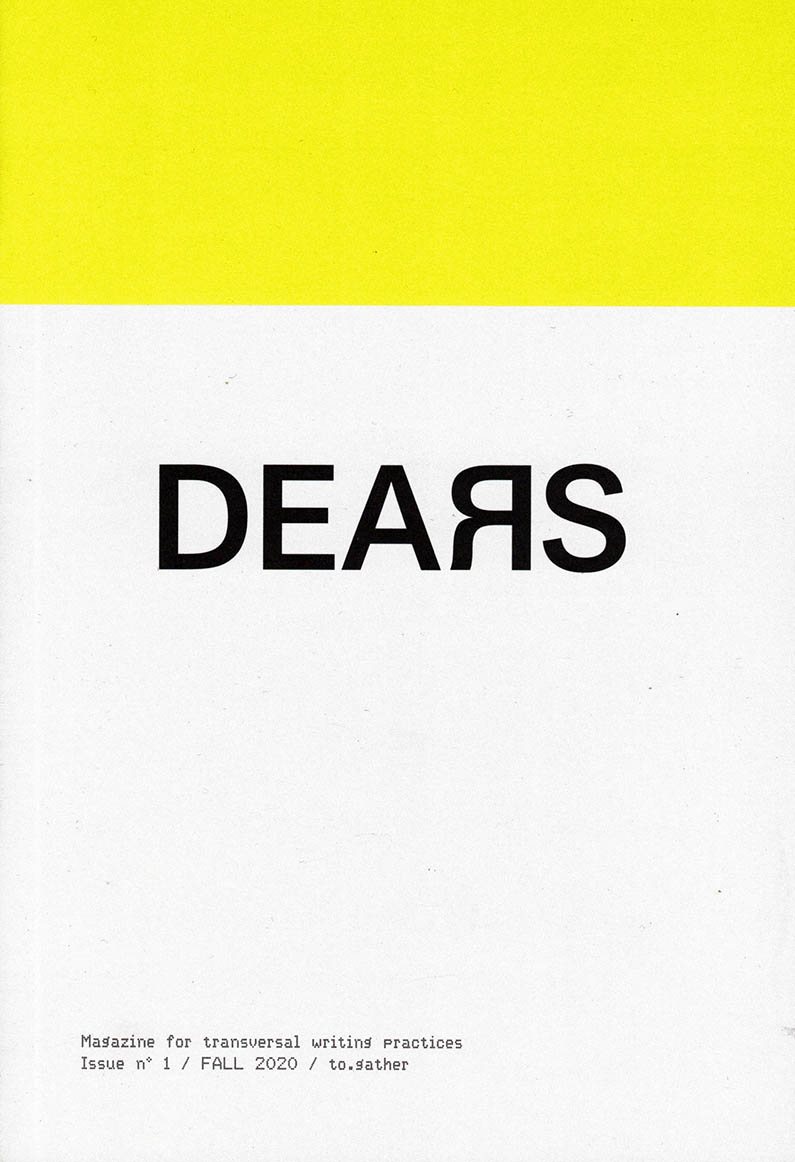
DEARS No. 1 TO.GATHER
Delphine Chapuis-Schmitz, Robert Steinberger and 1 more
DEARS Magazine on transversal writing, with texts by Season Butler, Crystal Z Campbell, Nicole Bachmann, Alessandro De Francesco, Benjamin Egger, Florinda Fusco, Gilles Furtwängler, Donna J. Haraway, Serafina Ndlovu, Rose Rand and Riikka Tauriainen.
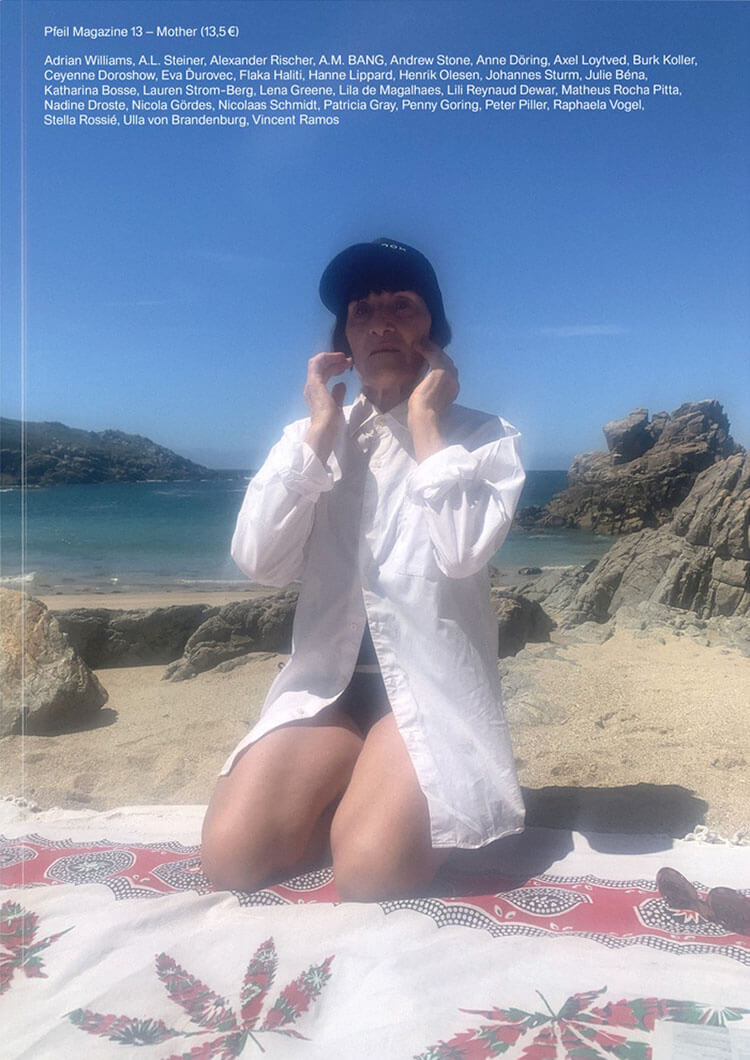
Pfeil Magazine #13 – Mother
The notion of a mother seems simple enough. But just one shy cut beneath the surface lies a multitude of facets, problems, questions, contradictions and wonders all connected to the idea of maternity. Biologically speaking, every person has a mother; perhaps it is the one fact we all have in common. Nevertheless this issue, dedicated to Mother, raises more questions than it is able to answer. Precisely because everyone appears to understand what a mother is, many crucial aspects of the topic are never questioned and are instead taken as a given. Is a mother defined by just having a child, or is it a child that defines the mother? Can we look at the mother without assuming womanhood? Can we untie the gendered attributes bound to the role of a mother? And what exactly are the notions of gender and sex that are connected to the common idea of motherhood? Where do they stem from? What kind of social, biological and economic pressure do mothers and potential mothers face?
In this issue, we explore alternative family structures and how responsibilities of parenting might be shared; prevailing working conditions for mothers in the arts; difficulties, challenges and prejudices mothers face in their professional lives, and what an ideal work environment might look like. Simultaneously, this issue deals with disappointments and unfulfilled expectations in the mother-child relationship, and again at that relationship in the social context. We picture the past and the present in the process of envisioning what maternity could look like in the future
Contributors
Adrian Williams, A.L. Steiner, Alexander Rischer, A.M. Bang, Andrew Stone, Anne Döring, Axel Loytved, Burk Koller, Ceyenne Doroshow, Eva Ďurovec, Flaka Haliti, Hanne Lippard, Henrik Olesen, Johannes Sturm, Julie Béna, Katharina Bosse, Lauren Strom-Berg, Lena Greene, Lila de Magalhaes, Lili Reynaud Dewar, Matheus Rocha Pitta, Nadine Droste, Nicola Gördes, Nicolaas Schmidt, Patricia Gray, Penny Goring, Peter Piller, Raphaela Vogel, Stella Rossié, Ulla von Brandenburg, Vincent Ramos.

Direct Into Chaos
Aleen Solari’s work is shaped profoundly by insights into various subcultures. These insights are partly drawn from her own experiences, partly borrowed from members of certain scenes who she invites to be part of her work. Her sculptural practice moves in and out of life within these groups, and is full of codes and quotations from antifa members, football hooligans, bored youth clubs or those embedded in neonazi networks.
Direct Into Chaos is a book that dives deep into these worlds, shape-shifting between fiction, documentation and artwork. In ghost written texts, Solari fictionalises her own artistic biography, morphing interviews with football hooligans who had their phones tapped by the police, into a dream world where they receive generous compensation for years lived under surveillance.
In this publication – in a chaotic, dreamlike state of mind – fiction and documentation, art and activism meld into something new.
Aleen Solari is an artist who lives in Hamburg, Germany
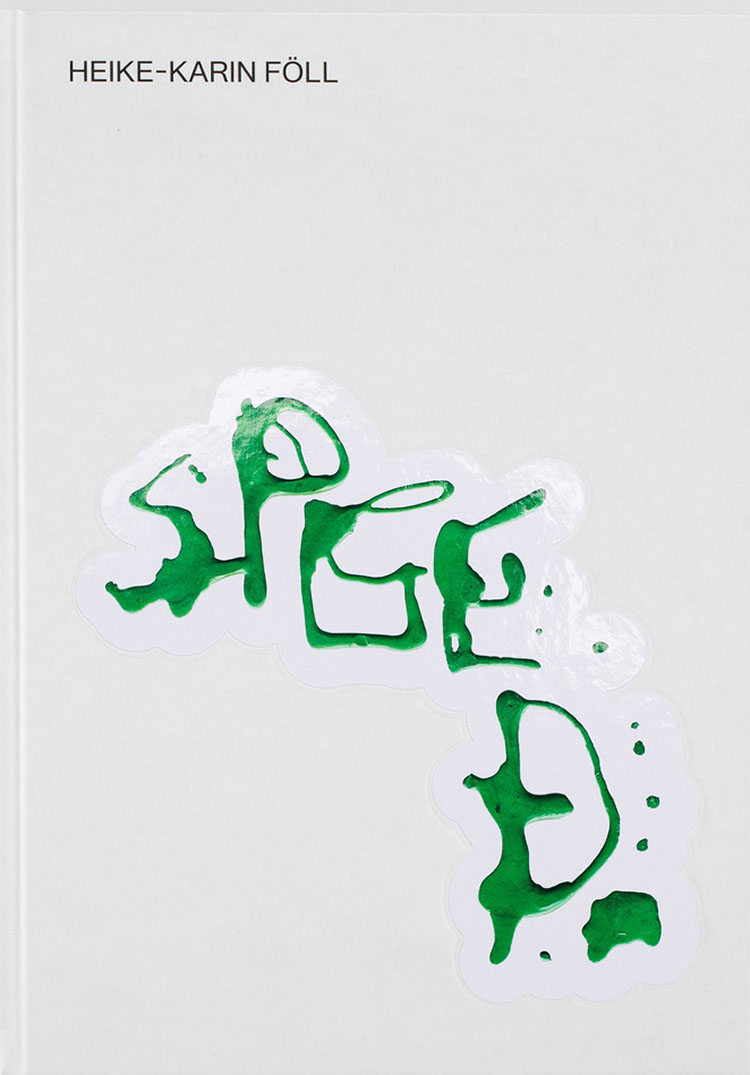
SPEED
Heike-Karin Föll’s foundational collection of works on paper refuses, in its totality, to be pinned down. SPEED exists in a sequence of autonomy, embracing simultaneity and resisting typical chronology or logic. A resource library for Foll’s more well known painted works, each page also stands on its own. The “writing” and “rewriting” of these pages is a rejection by the artist to rest on what has already been accomplished, and insists on constantly renewing modes of expression amidst the routine and expected.
SPEED takes the form of visual index, a micro structure of narrative, through the space of the page. Blank spaces (components of in-betweens and not-yets), textual elements, found images, and abstract icons are assembled from a daily stream of computational information and graphics to bring us into the temporal now. The pages slip from medium to medium, relying on short forms and small units as the bases for recontextualisation and variation. Montez Press is honoured to be able to offer an opening for these vast and untamable works by Heike-Karin Föll.
Heike-Karin Föll is painter who is currently based in Berlin. She works with the materiality and mechanics of painting and language, treating textuality as equally a vehicle of content, a visual motif and a material form.

Chubz: The Demonization of my Working Arse
Andy ‘Chubz’ Wilson is just another NEET on the street, spending his summer days sucking dick and chilling in the park, one hand on his touchscreen, the other down his pants. That is, until he meets charming left-wing journalist and cute crypto-twink Owen whilst trawling Grindr for sex. But what starts as a quick, breathless hookup ends up changing Chubz — and London — forever. Whilst Owen battles poppers-mad PM Nigel ‘Nige’ Farage, our cock-hungry comrade wages his own 'ass war', and is left wondering: just what exactly is it he’s fighting for? Socialism? Barbarism? Or just cheap kicks?
YOUTH RAGE! YOUTH VIOLENCE! YOUTH ORGASMS! FEAR OF A GAY UNDERCLASS – ARMED – DANGEROUS - SICK FUCKS.
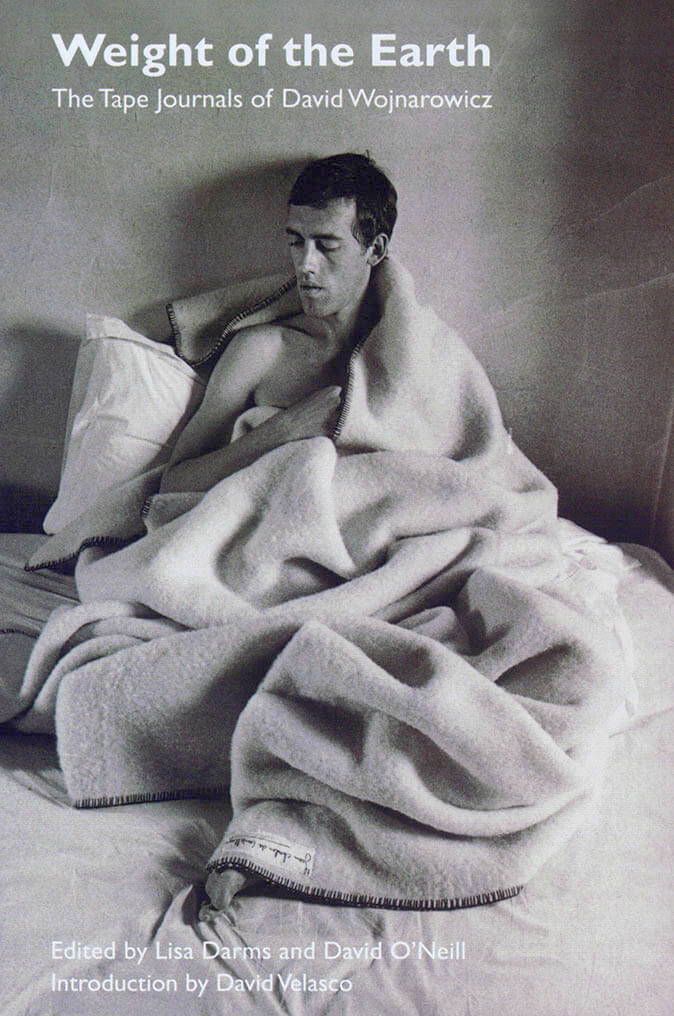
The Weight of the Earth
Audio journals that document Wojnarowicz's turbulent attempts to understand his anxieties and passions, and tracking his thoughts as they develop in real time.In these moments I hate language. I hate what words are like, I hate the idea of putting these preformed gestures on the tip of my tongue, or through my lips, or through the inside of my mouth, forming sounds to approximate something that's like a cyclone, or something that's like a flood, or something that's like a weather system that's out of control, that's dangerous, or alarming.... It just seems like sounds that have been uttered back and forth maybe now over centuries. And it always boils down to the same meaning within those sounds, unless you're more intense uttering them, or you precede them or accompany them with certain forms of violence.
—from The Weight of the Earth
Artist, writer, and activist David Wojnarowicz (1954-1992) was an important figure in the downtown New York art scene. His art was preoccupied with sex, death, violence, and the limitations of language. At the height of the AIDS epidemic, Wojnarowicz began keeping audio journals, returning to a practice he'd begun in his youth.The Weight of the Earth presents transcripts of these tapes, documenting Wojnarowicz's turbulent attempts to understand his anxieties and passions, and tracking his thoughts as they develop in real time.
In these taped diaries, Wojnarowicz talks about his frustrations with the art world, recounts his dreams, and describes his rage, fear, and confusion about his HIV diagnosis. Primarily spanning the years 1987 and 1989, recorded as Wojnarowicz took solitary road trips around the United States or ruminated in his New York loft, the audio journals are an intimate and affecting record of an artist facing death. By turns despairing, funny, exalted, and angry, this volume covers a period largely missing from Wojnarowicz's written journals, providing us with an essential new record of a singular American voice.
Published 2018
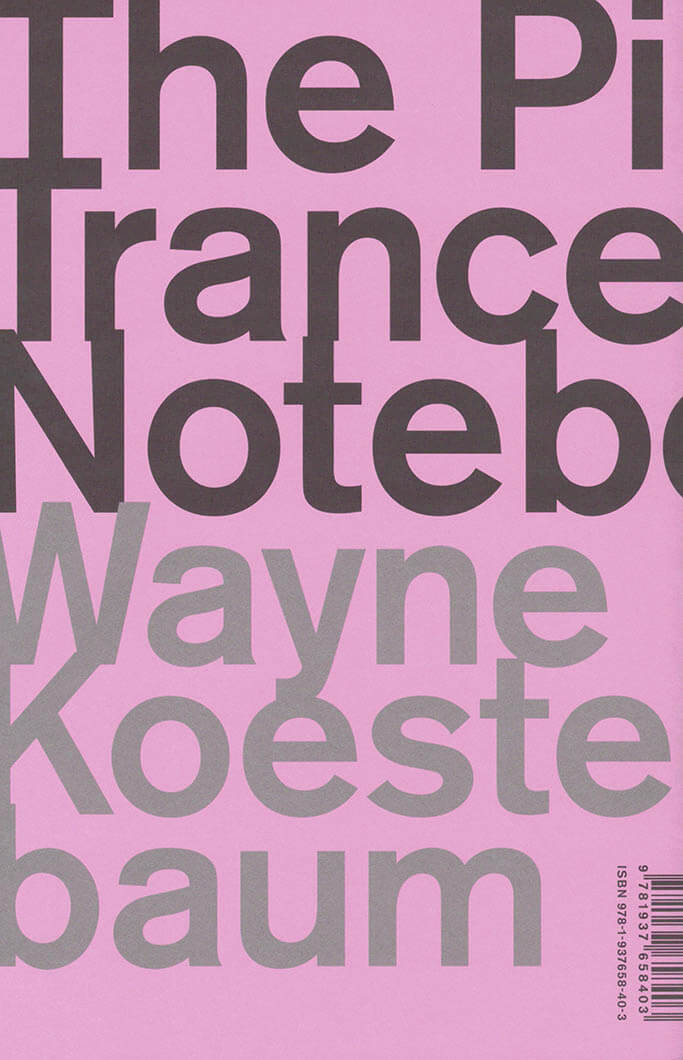
The Pink Trance Notebooks
The Pink Trance Notebooks is the product of the year Wayne Koestenbaum stopped keeping the traditional journal he had maintained for three decades and began a series of "trance notebooks" as a way to reflect an intensified, unmoored consciousness. The resulting sequence of 34 assemblages reflects Koestenbaum's unfettered musings, findings, and obsessions. Freed from the conventions of prose, this concatenation of the author's intimate observations and desires lets loose a poetics of ecstatic praxis—voiced with aplomb and always on point.
"Wayne Koestenbaum is one of the most original and relentlessly obsessed cultural spies writing today. His alarmingly focused attention to detail goes beyond lunacy into hilarious and brilliant clarity." —John Waters
WAYNE KOESTENBAUM is a poet and cultural critic. His recent books include My 1980s & Other Essays, Humiliation, The Anatomy of Harpo Marx, and the poetry collection Blue Stranger with Mosaic Background. He lives in New York City.
Published 2015.
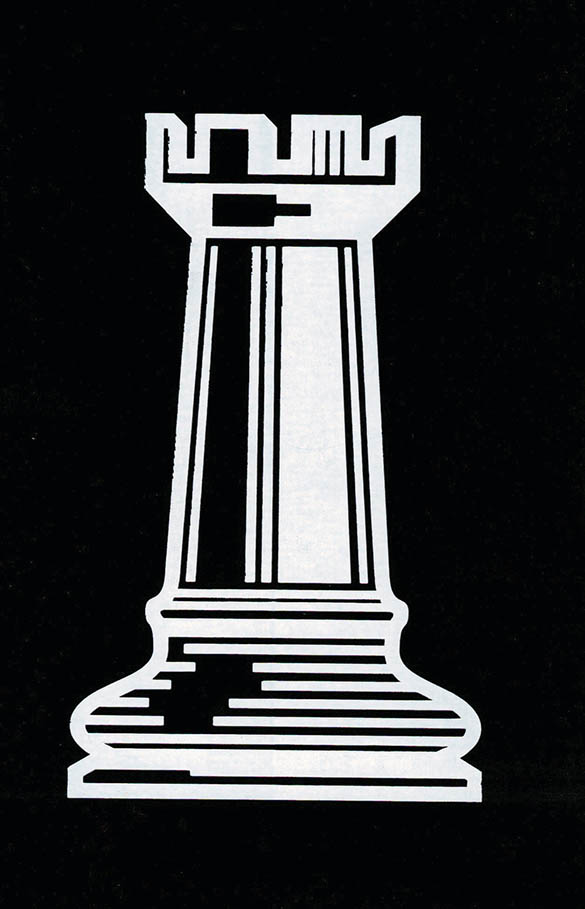
Insufficient Armour
A body of essays and visual contributions by radical theorists around the prosthesis and the "augmented body" issues.
"We all need means of supplementing our natural capabilities, since nature is indifferent, inhuman (extra-human), and inclement; we are born naked and with insufficient armour." — Le Corbusier
Once confined to the narrow circle of "medicalizing" practices, the prosthesis finally colonized our imagination thanks to the promise of an "augmented body" capable of undermining traditional dichotomies such as artificial vs. natural and organic vs. non-organic. But what are their speculative, theoretical and political repercussions? In this selection of original papers, the authors of Insufficient Armour reflect on the subject from their own peculiar perspectives, each of them contributing essays, political-philosophical analysis and theory fiction experiments.
Texts and contributions by Luigi Alberto Cippini, Matt Colquhoun, Helen Hester, Simon Sellars.

Enya: A Treatise on Unguilty Pleasures
Does music have to be smart or does it just have to go to the heart? In dazzling, erudite prose Chilly Gonzales’ musical memoir delves beyond the innumerable gold discs and millions of fans to excavate his own enthusiasm for Enya’s singular music and the mysterious musical herself, and along the way to uncover new truths about the nature of music, fame, success and the artistic endeavour.
Chilly Gonzales is one of the most exciting, original, hard-to-pin-down musicians of our time. Filling halls worldwide at the piano in his slippers and a bathrobe—in any one night he can be dissecting the musicology of an Oasis hit, giving a sublime solo recital, and displaying his lyrical dexterity as a rapper. In his book about Enya, he asks: Does music have to be smart or does it just have to go to the heart? In dazzling, erudite prose Gonzales delves beyond her innumerable gold discs and millions of fans to excavate his own enthusiasm for Enya’s singular music as well as the mysterious musician herself, and along the way uncovers new truths about the nature of music, fame, success and the artistic endeavour.
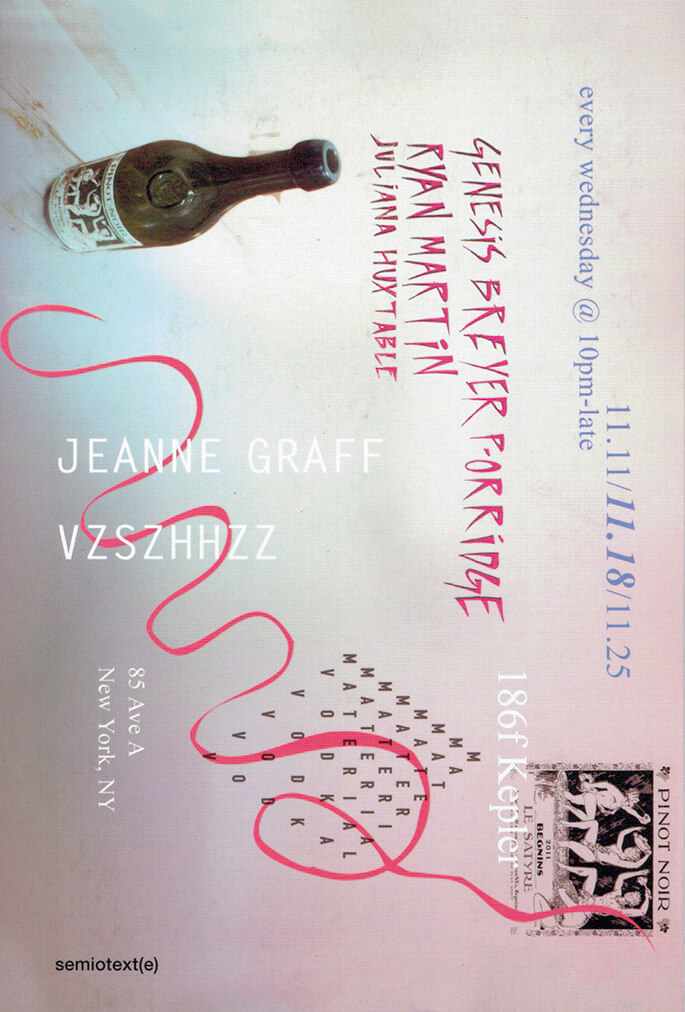
Vzszhhzz
Composed between destinations, in airplanes, trains, museums, and bars over three years, Jeanne Graff's Vzszhhzz captures the slight intersections of a loose group of artists and lawyers, restauranteurs, philosophers, wine-makers and boxers whose lives are conducted almost entirely in a second language. A loose chronicle masquerading as a novel, Vszhhzz - like Michèle Bernstein's All The King's Horses, the Bernadette Corporation's Reena Spaulings, and Natasha Stagg's Surveys - couches Graff's sharp observations in a laconic and ambient style. By not saying too much, Vzszhhzz says everything about the relation to time, cities, weather and smog that has become the lingua franca of a creative and transient life.
Writer and curator Jeanne Graff was born in Lausanne, Switzerland and lives in New York. She is a columnist for May Revue (Paris), works in a vineyard, and teaches at HEAD art school in Geneva. In 2014, Graff founded 186f Kepler, an art space without walls. She has organized numerous international exhibitions, and performs with her band Solar Lice. Graff recently completed a writing residency at Villa Noailles in Hyeres, France.

Castle Faggot
In Derek McCormack's home province, farm boys with growing pains enjoy a little-known meal called bed-supper, a hearty bowl of sweet breakfast cereal enjoyed as a midnight snack. Here McCormack has composed a peculiarly salacious bed-supper, where the long secret sweet-tooth of the Marquis de Sade glints as it sinks into the dirtiest of dishes. This useful book will more than stay your appetite until breakfast — Castle Faggot is also a manual of redecoration, a musical, a puppet show, a theory of cosmetics, a work of poetics, and a glorious celebration of the French decadence. — Lisa Robertson, author of The Baudelaire Fractal
Derek McCormack is a writer who lives in Toronto. His previous books include The Show that Smells and The Well-Dressed Wound (Semiotext(e)).

Faux Pas
Essays on art-making, abstraction, humor, not-knowing, awkwardness and more, from one of New York’s most influential and popular painters and teachers
Since the 1970s, Amy Sillman—a beloved and key figure of the New York art scene—has developed a singular body of work that includes large-scale gestural paintings blending abstraction with representation, as well as zines and iPad animations.
Over the past decade, Sillman has also produced stimulating essays on the practice of art or the work of other artists: for example, reevaluating the work of the abstract expressionists with a queer eye; elaborating on the role of awkwardness and the body in the artistic process; and discussing in depth the role and meanings of color and shape. Featuring a foreword by Lynne Tillman, Faux Pas is the first book to gather a significant selection of Sillman’s essays, reviews and lectures, accompanied by drawings, most of them made specially for the book.
Faux Pas aims at revealing the coherence and originality of Sillman’s reflection, as she addresses the possibilities of art today, favoring excess over good taste, wrestling over dandyism, forms over symbols, with as much critical sense as humor. As Jason Farago notes in the New York Times, "Sillman is in a thin crowd (with, let’s say, Andrea Fraser, Hito Steyerl, Matias Faldbakken, David Salle) of artists who can really write. The evidence is in Faux Pas ... her writings display the same good humor and intelligence of her best paintings."
Based in New York City, Amy Sillman (born 1955) is an artist whose work consistently combines the visceral with the intellectual. She began to study painting in the 1970s at the School of Visual Arts and she received her MFA from Bard College in 1995. Her work has been exhibited internationally, including at the Whitney Biennial in 2014; her writing has appeared in Bookforum and Artforum, among other publications. She is currently represented by Gladstone Gallery, New York.
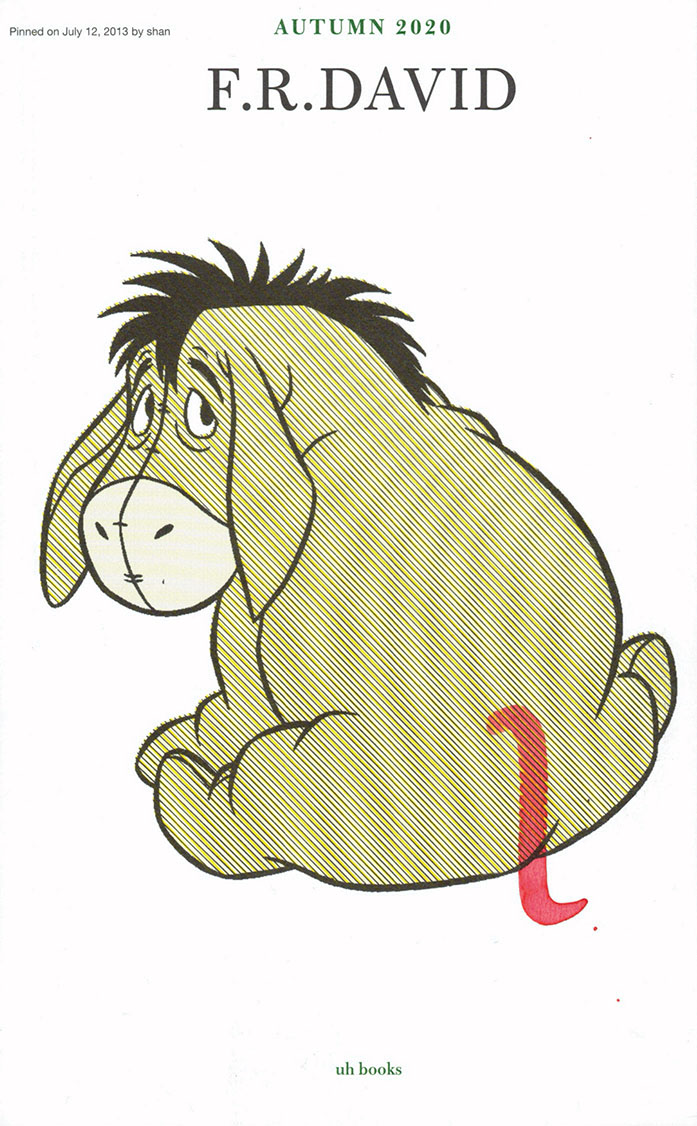
F.R. David - Correctional Facility
F.R.DAVID is a typographical journal, dealing with the organisation of reading and writing in contemporary art practises. The 20th issue, “Correctional Facility” is edited by Will Holder paying attention to difference; and transformations between
accident⎱design 249
acorn⎱oak 293–94, 297–98
adult⎱child 95, 139, 207, 308
alphabetic⎱postliterary 3
alphabetic⎱postalphabetic 3, 5
alphabetic⎱analphabetic 5
analytic⎱linguistic 298
ankh⎱kiss
angles⎱angels 162
aristocrat⎱ass 12
ass⎱man 28
aye⎱eye 160
bad⎱good 130
(outstandingly⎱remarkably)
before⎱after 19, 49, 51, 158,
201, 263, 305
bitter⎱sweet 65, 163, 217
both⎱and 8, 119, 123, 160, 173, 180, 245, 292, 298
cart⎱horse 2, 9
coming into being⎱passing away 318
communism⎱democracy 319
composition⎱improvisation
163, 168, 170
concrete⎱abstract 288
dark⎱light 43, 64, 127, 223,
261, 300, 309, 316
diegetic⎱non-diegetic 145, 193
dropped out⎱drop doubt 160
either⎱or 6, 14, 39, 43, 54, 85, 119, 120, 132, 195, 223, 249, 288
emotional⎱intellectual 297
enthusiastic⎱tempered 13, 78, 205
ἕν καἰ τὀ πᾶν⎱one and all 224
everything⎱fragment 33, 138
everything⎱all things 218–22
experience⎱attention 39, 40, 65, 254–5
green⎱blue 127
high modernism⎱post-structuralist⎱postmodernism 165
radical modernism⎱modernism⎱
postmodernism 4, 164–66
I⎱sigh 160
image⎱word 6, 72, 316–18
Isis⎱Isis 226
jar⎱jars 76, 158, 159
left⎱right 7, 28, 127, 217
meaningful⎱meaningless 258
oak (a⎱ok) 290, 293–94, 297–98
orality⎱textuality 3, 264
phoneme⎱letter 180
phonetic⎱ideogrammatic 297
shit⎱gold †
signal⎱noise 39, 40, 65, 254–55
sweat⎱tears 292
tail⎱bell-rope 151, 154
thesis⎱antithesis 322
written⎱unwritten 158, 296–97
vowel⎱consonant 180–82, 292
we are⎱we ain’t 93
white pawn⎱white pawn 224
word⎱world 8, 12, 138, 160, 165, 166, 180, 183, 260, 265, 287, 298, 300, 315, 317
writing⎱nature 27, 44, 83, 120,
121, 126, 166, 183, 198, 203,
219–20, 252, 297, 318–19
Published October 2020.
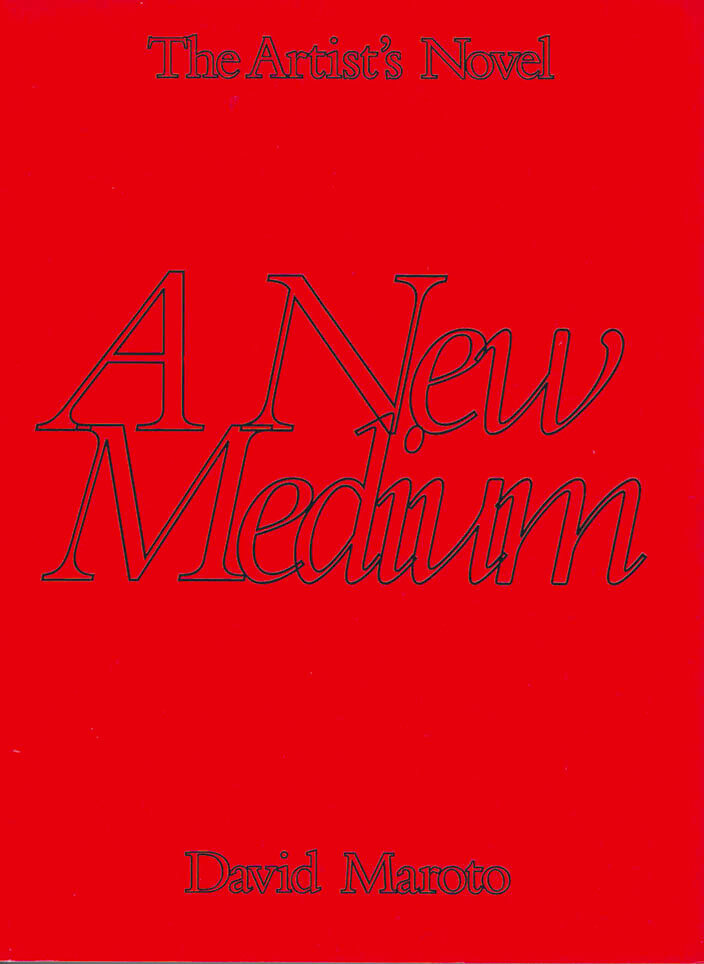
A New Medium
The first of a two-volume publication dedicated to the artist's novel, this theoretical essay aims to elucidate the pressing questions posed by the emergence of this new artistic medium with a number of key case studies and interviews.
Why do artists write novels? What impact does the artist's novel have on the visual arts? How should such a novel be experienced? In recent years, there has been a proliferation of visual artists who create novels as part of their broader art practice. They do so in order to address artistic issues by means of novelistic devices, favoring a sort of art predicated on process and subjectivity, introducing notions such as fiction, narrative, and imagination. In this sense, it is possible to see the novel as a new medium in the visual arts; yet very little is known about it. This two-volume publication is the first to explore in depth the subject of the artist's novel.
Part 1, A New Medium, is a theoretical examination that looks critically at the different ways contemporary artists employ the artist's novel, focusing mainly on four key case studies: Benjamin Seror's Mime Radio, Cally Spooner's Collapsing in Parts, Mai-Thu Perret's The Crystal Frontier, and Goldin+Senneby's Headless. It seeks to situate the artist's novel within the broader context of the visual arts in the hopes of sparking a much-needed discussion about a practice that has long been ignored by critical strands in art discourse. It includes valuable resources, such as the only existing bibliography of artists' novels.
Interviews with Benjamin Seror, Cally Spooner, Mai-Thu Perret, Goldin+Senneby, Francis McKee, Vivian Ziherl, Natasha Soobramanien, Clive Phillpot, Alex Cecchetti, Łukasz Gorczyca, Jan Jasiński.

Experiments in Joy
Gabrielle Civil's Experiments in Joy celebrates black feminist collaborations and solos in essays, letters, performance texts, scores, images, and more. Following her explosive debut Swallow the Fish, Civil now documents her work with From the Hive, No. 1 Gold, and Call & Response—whose collaborative Call inspired the title. The book also features her solo encounters with artists and writers, ancestors and audiences. Here you will find black girlhood, grief, ghosts, girls in their bedrooms, lots of books, dancing, reading, falling in love, fighting back, and flying. With lots of heart and the help of her friends, Civil keeps reckoning with performance, art and life.
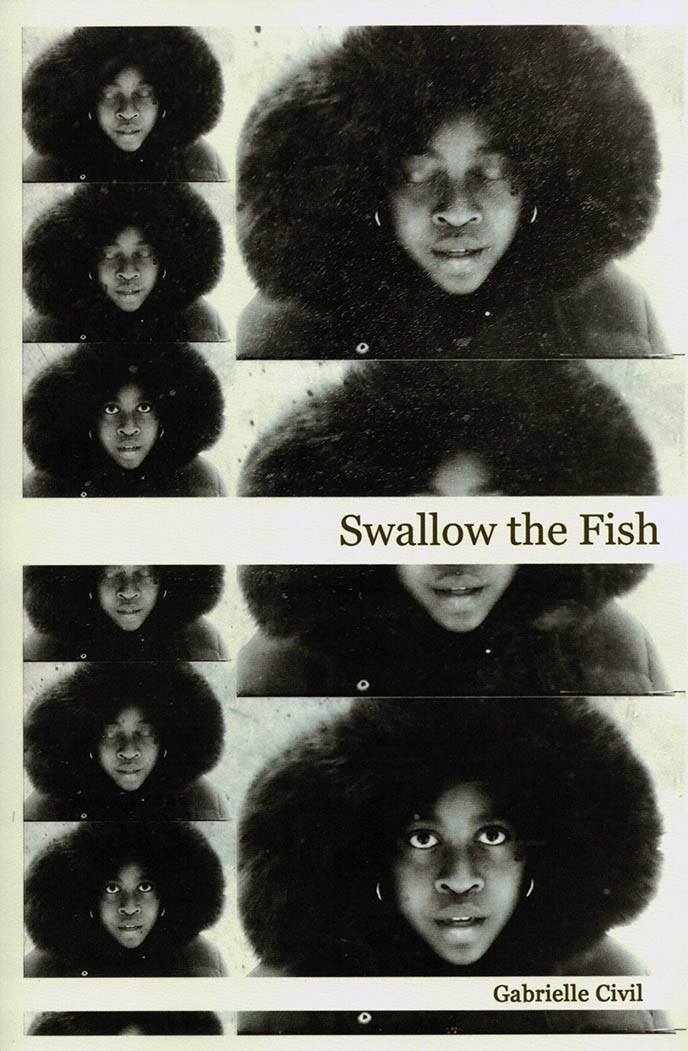
Swallow the Fish
Gabrielle Civil's Swallow the Fish is a memoir in performance art that explores the medium from within its beating heart. Adding its voice to black feminist conversations, it combines essays, anecdotes, and meditations with original performance texts to confront audience, motivation, and fears. Both joy and panic appear in Civil's world of performance, where neither walls nor city limits set the scope of the stage. Civil bares vulnerabilities and enthralls readers, asking essential questions and embodying dreams.
Published 2017.

Licorice
'Licorice' is a novel, a mixed-up tale about a film, a windmill and city folk. The plot involves the making of a film by characters who are trying to gain permission to record the noises inside a reconstructed windmill to use as its soundtrack. When they don't succeed, the eponymous character Licorice makes an Aeolian harp out of bits she finds in a small electricals recycling bin. Licorice is the first title in the forthcoming Interstices series of books guest edited by Brighton based author Bridget Penney, whose previous publications include Honeymoon with Death and Other Stories (Polygon, 1991) and Index (Book Works, 2008).
144 p, ills colour & bw, 11 x 18 cm, pb, English
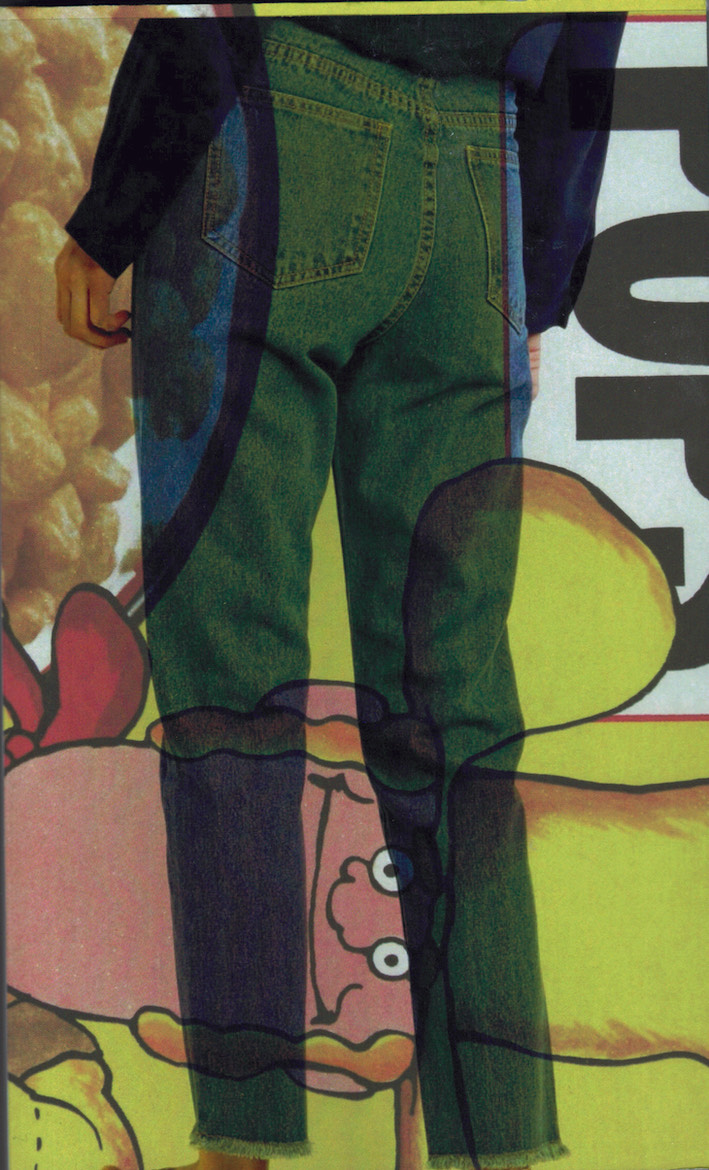
Homophone Dictionary
Homophone Dictionary was originally a file that is compiled by the now 96-year-old former schoolteacher Susan Nixon. She has build up many collections throughout her life, almost all of them exist out of objects, except one: after her retirement she compiled a word document that by now exist out of almost 1000 homophones; two, or more words that you pronounce similar but have a different meaning, often the spelling is also different.
The document is structured as a dictionary and the homophones are illustrated with examples that are based on autobiographical information. The structure of Homophone Dictionary also refers to speech therapy exercises and concrete poetry.
“As a student nurse learning medical terminology, I became fascinated with understanding the roots of words. When I had a young family, words were a principal source of entertainment: it was not unusual for one of the children to slip from their chair at the dinner table and fetch a dictionary in order to settle a dispute or satisfy someone’s curiosity. Then I became a teacher and brought this love of words into the classroom. My habit of word collecting became the children’s habit – my pupils became ‘word-lovers’ and ‘list-makers.’
I casually collected homophones for years. When introducing homophones into the classroom, the kids found definitions dull; the typical reaction was, ‘Yes, but give me a sentence using the word!’ and this idea emerged: a book of sentences demonstrating the meanings of homophone pairs or sets.”
Author Sue Nixon, editor Riet Wijnen, Offset print
20,4 × 12,4 cm, 423 pages
edition of 500
Published 2020